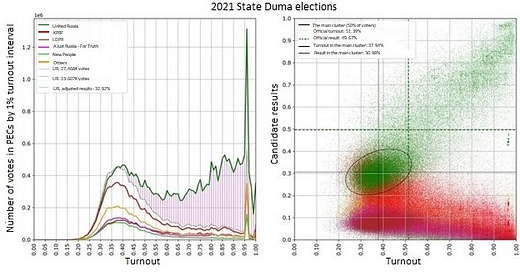President Donald Trump won Iowa in the November election with 56% of the vote, while Kamala Harris received 43% of votes cast.
Ann Selzer’s 2024 Iowa pre-election poll projected a 47% to 44% lead for Vice President Kamala Harris over President Donald Trump. However, the final results showed a significant deviation, with Trump winning Iowa decisively by a 13-point margin. This discrepancy led to scrutiny of her polling practices, and Selzer retired soon after the election.
Trump filed a lawsuit over the poll in December, and in January another group sued the Des Moines Register for the Ann Selzer poll, claiming it “delivered the dictionary definition of fake news”.
The Election Truth Alliance (ETA) has conducted statistical analysis of swing states such as Nevada and Pennsylvania for the 2024 Presidential Election, uncovering concerns regarding potential vote manipulation. Applying similar methods, we are examining Iowa’s results to understand why one of the nation’s most experienced pollsters appeared to be so far off the mark.
Our initial focus is on absentee and election day voting in Johnson County, Iowa’s fifth-largest county, representing 5% of the state’s 3.241 million residents. Absentee voting in Iowa includes both mail-in and early voting.
Our first analysis plots votes cast per precinct (x-axis) against the percentage of votes each candidate received (y-axis). Given the mixed nature of absentee voting, some shifts are expected at different turnouts due to these being two separate vote types combined.
The turnout analysis methodology aligns with the Kiesling-Shpilkin method approach, using voter turnout data to identify positive or negative trends as turnout increases and could detect potential irregularities.
For reference, below is an example from Russia’s 2021 State Duma elections, which statisticians claimed half pro-kremlin votes could have been falsified:
We will only be utilizing the right-side (image above) method of analyzing turnout for this first post.
Vertical axis – candidate result
Horizontal axis – turnout by polling station
Our turnout analysis uses the same x-axis for turnout and y-axis for candidate vote percentage but focuses on precinct-level data instead of polling locations.
This is Johnson County Absentee votes for the 2024 Presidential race.
Observations:
For Harris, there is a slight upward trend as turnout grows from 20% to 61%.
For Trump, there is a slight downward trend as turnout grows.
Does this indicate manipulation?
Since absentee voting combines two distinct methods, further baseline data must be gathered from other races—both presidential and down-ballot—to determine whether these trends reflect irregularities or other explainable factors.
When looking at the vote data by votes cast (x-axis) to candidate vote share (y-axis), we see more of the same slow growth at higher turnout for Democrats here.
Further analysis of Iowa will highlight if this is unique to the county or something more.
Johnson County Election Day: On Election Day, a more pronounced shift emerges:
Republican vote at lower turnout is low and grows as turnout increases.
Democratic vote share declines as turnout rises.
Is this an indication of manipulation?
Since this is one vote type, there are concerns about why this trend is apparent.
These trends also parallel concerns observed in three Pennsylvania counties, warranting further investigation.
When reviewing the voting data by votes cast (x-axis) to candidate vote share (y-axis), we see interesting changes.
Democrats begin at a lower vote share, grow their votes as votes are cast, then steadily decrease.
Republicans mirror this.
This rapid change seen as “votes cast” increases per precinct is a concern, and so as we continue our analysis, we have specific questions to ask and answer:
Key Questions:
How does Johnson County compare to other counties in Iowa?
How does the presidential race compare to other down-ballot partisan and nonpartisan contests?
Further updates will follow as our analysis progresses. We welcome questions about our methodology and findings.
Disclaimer: Election Truth Alliance (ETA) is a non-profit, nonpartisan, volunteer-led organization dedicated to free and fair elections. Our present focus is on the 2024 Presidential Election in which we took a keen interest after election and cybersecurity experts announced the appearance of numerous irregularities in the election results. For this endeavor, ETA brought together a broad range of experts, which span across multiple disciplines, including, but not limited to, data analysis, political science, cybersecurity, auditing, computer engineering and bioengineering. Opinion and analysis is based on current data available.
ETA employed a data-driven analysis of the Cast Vote Records (CVR), corresponding voter data, ballot images and other accessible information; such analysis was performed at each stage of the voting process, from early in-person voting, mail in ballots to day of in-person voting.
All posts are subject to update as new or corrected information is brought to our attention, or if there is other information to share with readers.










Tulsa County in Oklahoma might worth looking into as well. Yes, is historically red in an entirely red state, however, the early voting only had 2 voting locations and both were packed for days. We also had a Mayoral run off election on Election Day. Because it was a runoff, it was on a completely different ballot. Citizens of Tulsa elected their first Black Mayor, winning with
76,300 votes at 55.62% of the vote. If Drump won Tulsa County by more than 60%… something could be up.
ETA - you guys are on fire! Along with you, Ann Selzer is my hero. She stood by her results and yes, she retired, only because it was pre-planned. I disagree that she left in shame, not after a stellar career like that. Trump had no reason to sue her other than to make her look bad, muddy the waters, and be his petty self. Its a CONFESSION of sorts.
Her poll was one of the last pieces of reality-based information (and hopium) I had ahead of the election, and I’ve continued to believe the poll since then.